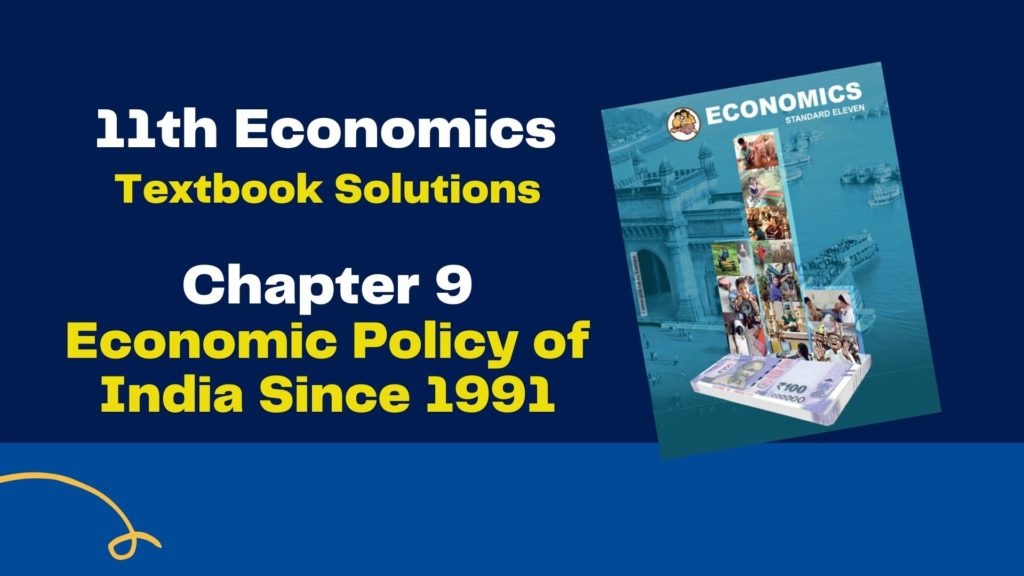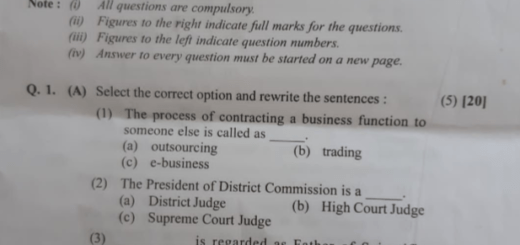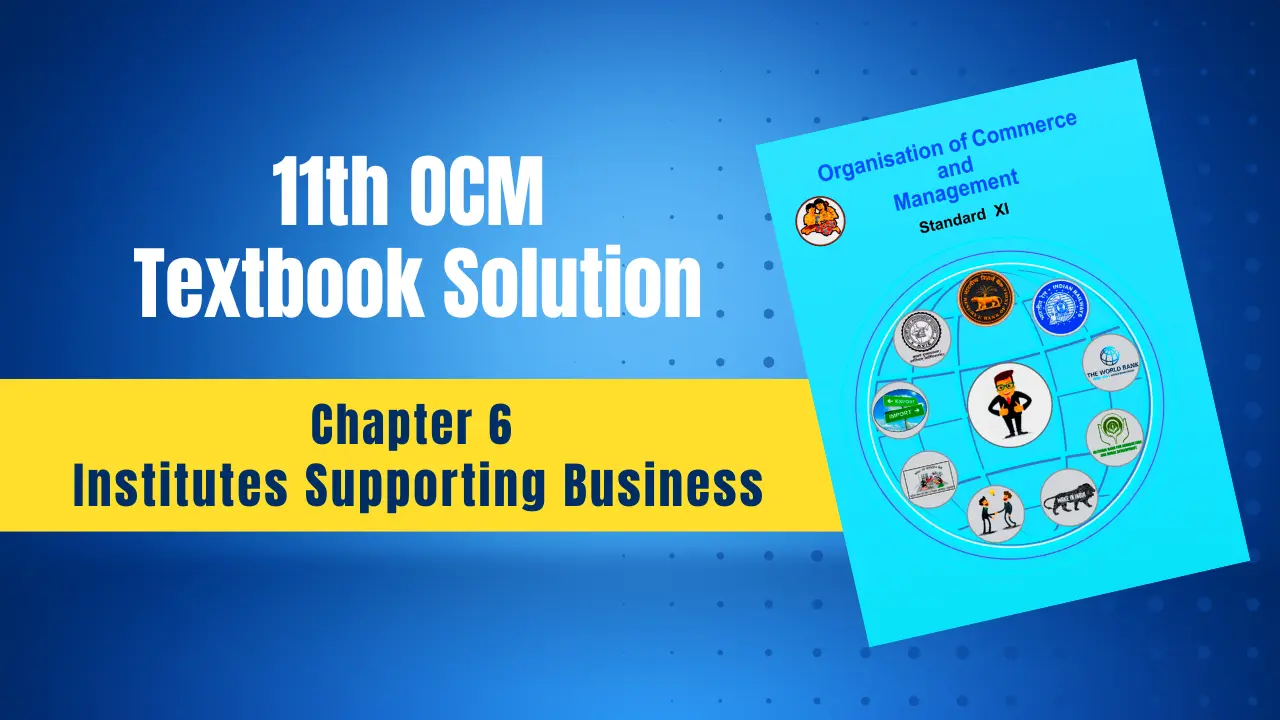11th Economics Chapter 9 Exercise Solution (Economic Policy of India Since 1991) Maharashtra Board – Free Solution
Table of Contents
11th Economics Chapter 9 Exercise

Chapter 9 – Economic Policy of India Since 1991
Q. 1. Complete the following statements by choosing the correct alternative
1) After Independence, India had adopted _____.
a) Socialism
b) Capitalism
c) Mixed Economy
d) Communism
2) The new economic policy approved foreign technology in _____.
a) Cottage industries
b) Small scale industries
c) Micro-enterprises
d) High priority industries
3) At present, the number of industries reserved for the public sector has been reduced to _____.
a) 3
b) 5
c) 7
d) 2
Q. 2. Assertion and Reasoning questions
1) Assertion (A): Delicensing of industries was an important step taken under liberalization.
Reasoning (R): Unwanted controls and restrictions led to economic stagnation prior to 1991.
Options:
a) (A) is TRUE but (R) is FALSE
b) (A) is FALSE but (R) is TRUE
c) (A) and (R) both are TRUE and (R) is the correct explanation of (A)
d) (A) and (R) both are TRUE but (R) is not the correct explanation of (A)
2) Assertion (A): In 1990-91, India faced an acute shortage of foreign exchange reserves.
Reasoning (R): Import quotas and tariffs led to an increase in imports.
Options:
a) (A) is TRUE but (R) is FALSE
b) (A) is FALSE but (R) is TRUE
c) (A) and (R) both are TRUE and (R) is the correct explanation of (A)
d) (A) and (R) both are TRUE but (R) is not the correct explanation of (A)
3) Assertion (A): Post liberalization, the sale of domestic goods has increased.
Reasoning (R): The demand for imported goods had increased due to liberal policy.
Options:
a) (A) is TRUE but (R) is FALSE
b) (A) is FALSE but (R) is TRUE
c) (A) and (R) both are TRUE and (R) is the correct explanation of (A)
d) (A) and (R) both are TRUE but (R) is not the correct explanation of (A)
4) Assertion (A): Due to Globalisation, a country cannot achieve self-sufficiency in food production.
Reasoning (R): Globalisation has created a revolution in IT sector.
Options:
a) (A) is TRUE but (R) is FALSE
b) (A) is FALSE but (R) is TRUE
c) (A) and (R) both are TRUE and (R) is the correct explanation of (A)
d) (A) and (R) both are TRUE but (R) is not the correct explanation of (A)
Q. 3. Find the odd word out
1) New Economic Policy –
Liberalization, Privatization, Demonetization, Globalisation
2) Industries requiring compulsory licensing –
defence equipment, agro-based industries, cigarettes, industrial explosives
3) Navratna status companies –
SPCL, IOC, ONGC, HPCL
4) Liberalization dealt with the following –
MRTP, FERA, SEBI, NTPC
Solution of other subjects
Solution of all Chapters of Economics
1 – 2– 3 – 4 – 5 – 6 – 7 – 8 – 9 – 10
Q. 4. Identify and explain the concepts from the given illustrations
1) Vehicles manufactured by various automobile companies are now available in India.
Concept: Globalisation
Explanation: Globalisation means the creation of a global economy. A Global economy is a borderless economy having a free flow of goods and services, capital, labour and technology across the national borders.
2) Government equity in some public sector enterprises is sold to the private sector.
Concept: Privatisation
Explanation: Privatisation means the transfer of ownership from public to private sector. In the broader sense, it means introduction of private management and control with or without change in ownership of public enterprise.
3) Foreign investments are encouraged on a large scale in the industrial sector of India.
Concept: Foreign Direct Investment (FDI)
Explanation: Industrial policy of 1991 approved Foreign Direct Investment (FDI) to encourage investment in high-priority industries requiring high investment and technology.
Q.5. State with reasons whether you agree or disagree with the following statements
1) Liberalisation has permitted the use of foreign technology.
Answer: Yes, I agree with this statement.
Reasons: a) Liberalisation has allowed the use of foreign technology in high-priority industries.
b) Foreign technology helps to reduce the cost of production.
c) Due to the use of foreign technology Indian industries became competitive.
d) Thus, Liberalisation has permitted the use of foreign technology.
2) Government has given private enterprises free access to public sector.
Answer: Yes, I agree with this statement.
Reasons: a) By disinvestment government sells the shares of sick public sector units to the private sector. e.g. Disinvestment of Maruti, ITDC hotels, IPCL, VSNL etc.
b) The Industrial policy of 1956 reserved 17 industries for the public sector. But, NEP reduced this number to only two.
c) At present only railway transport and atomic energy are reserved for the public sector.
d) Thus, government has given private enterprises free access to public sector.
3) Government has monopoly in insurance sector.
Answer: No, I disagree with this statement.
Reasons: a) Insurance sector was a monopoly of the government till 1999.
b) The new policy passed Insurance Regulatory and Development Authority Act (IRDA) in 1999 to introduce reforms in this sector.
c) The IRDA has given licences to many private companies to enter insurance business.
d) This has ended the monopoly of Government in this sector.
4) The creation of National Renewal Board was done to remove poverty.
Answer: Yes, I agree with this statement.
Reasons: a) When the loss making public sector units are closed, the workers have to face the problem of unemployment and poverty.
b) To solve this problem, government has created National Renewal Board (NRB).
c) NRB takes the responsibility of providing compensation to the retrenched workers which help to reduce poverty.
d) Thus, the creation of National Renewal Board was done to remove poverty.
5) Indian Oil Corporation is one of the public sector units among ‘Navratnas’.
Answer: Yes, I agree with this statement.
Reasons: a) During 1997-98, nine public sector units were selected and given the status of ‘Navratnas’ based on their performance.
b) These Navratnas were given full financial and managerial autonomy.
c) Indian oil corporation is one of these nine Navratnas.
d) Thus, Indian Oil Corporation is one of the public sector units among ‘Navratnas’.
Solution of other subjects
Solution of all Chapters of Economics
1 – 2– 3 – 4 – 5 – 6 – 7 – 8 – 9 – 10
Q.6. Answer in detail
1) Explain the features of economic policy of 1991.
Answer: Features of the Economic Policy of 1991
1) Delicensing
It means abolition of government license required to carry on any business or industrial activity. All industries
except for 18 specified industries of strategic importance required license.
2) Abolition of Monopolies and Restrictive Trade Practices (MRTP) Act
According to MRTP Act, it was compulsory for large industrial houses to take the approval of Central government for establishment, expansion, merger etc. This resulted in slow industrial growth. Abolition of MRTP Act has encouraged industrial growth.
3) Encouragement to small sector
The government encouraged small sector units to attain a higher growth rate in output, employment, and export sector. Its investment limit was increased from 1 crore to 5 crore.
4) Encouraging foreign investment
Industrial Policy of 1991 approved Foreign Direct Investment (FDI) to encourage investment in high priority industries requiring high investment and technology. Initially, FDI was permitted upto 51% of total investment in selected industries. Later this limit was raised to 74% and then 100% for specific industries.
5) Reducing role of Public Sector
To encourage private sector, NEP reduced the number of industries in public sector from 17 to 8. From 2014, there are only two industries reserved for public sector which include railways and atomic energy.
6) Trade Liberalisation
Import licensing controls have been abolished. Almost all capital goods, raw materials, intermediate goods and other components were made freely importable. Established exporters are allowed to raise external credit to finance their trade. Special Economic Zones (SEZ) are set up to promote exports.
7) Reforms in Insurance Sector
Insurance sector was a monopoly of the government. The new policy passed Insurance Regulatory and Development Authority Act (IRDA) in 1999 to introduce reforms in this sector. The IRDA has given licence to many private companies to enter insurance business.
8) Reforms in financial sector
Earlier only co-operative banks and public sector banks were permitted to do banking business in the financial sector. The new economic policy has also permitted the entry of new private banks and foreign
2) Explain the measures undertaken for Globalisation.
Answer: Following are the measures taken for Globalisation:
1) Removal of quantitative restrictions
All the quantitative restrictions have been removed on imports and exports. Further tariff rates have been brought down considerably. The import duty on industrial goods have been reduced.
2) Encouragement to Foreign Capital
Government has opened the economy to foreign investments. As a result, foreign capital is attracted towards various sectors. Indian economy has become a part of global economy.
3) Convertibility of Rupee
Exchange rate of rupee has been made flexible. Rupee is made fully convertible to all current account transactions.
4) Foreign collaboration
Indian companies are allowed to enter into important foreign collaborations, e.g. Maruti-Suzuki, Hero-Honda, and Tata-Corus deal of iron and steel in South Africa.
5) Long term trade Policy
To ensure longer duration in foreign trade, changes were made in the foreign trade policy. Main features of this policy included :
a) Liberalised policy
b) Removal of restrictions on foreign trade.
c) Encouragement to Foreign Collaboration.
6) Encouragement to Exports
Through EXIM policy, various incentives are given to exporters. Special Economic Zones are created to encourage exports.
Q.7. Read the following passage carefully and answer the questions.
Indian ice cream industry is one of the fastest growing segments of the dairy and food processing sector. India has a low per capita consumption of ice cream of 400 ml whereas in USA it is 22,000 ml and in China, it is 3000 ml.
The per capita consumption of ice cream is low in India because it is a country filled with traditional sweets of more than 100 varieties. In developed countries, people have either pastries or ice-creams for dessert. In the era of Globalisation, the mindset of the people is fast changing. This is because multi-national companies have set up a number of ice-cream parlours, with a lot more varieties and flavours that attract the younger lot. Besides this, there are better delivery systems.
The ice cream sector has great potential for growth in the country due to improvements in the cold chain infrastructure, increasing disposable income, and changing lifestyle of the people. However, it is taxed higher with 18 percent GST while other dairy products in the same basket such as butter and cheese are taxed at 12 percent.
The ice cream industry has generated revenue of more than $1.5 billion in 2016-17. With employment of 15 lakh people directly or indirectly, it is also considered one of the largest employers of the dairy and food processing industry.
1) Identify the reason for low per capita consumption of ice cream in India.
Answer: The per capita consumption of ice cream is low in India because it is a country filled with traditional sweets of more than 100 varieties.
2) Explain the impact of Globalisation on the Indian ice-cream industry.
Answer: Due to Globalisation, the mindset of the people is fast changing. This is because multi-national companies have set up a number of ice-cream parlours, with a lot more varieties and flavours that attract the younger lot.
3) Find out the factors that could lead to the growth of ice cream industry in India.
Answer: The ice cream sector has great potential for growth in the country due to improvement in the cold chain infrastructure, increasing disposable income and changing lifestyle of the people.
4) Express your views about the implications of higher GST on ice cream industry in India.
Answer: Ice Cream Sector is taxed higher with 18 percent GST while other dairy products in the same basket such as butter and cheese are taxed at 12 percent.
Solution of all Chapters of Economics
| Chapter Name | Solution Link |
| 1) Basic Concepts in Economics | Solution |
| 2) Money | Solution |
| 3) Partition Values | Solution |
| 4) The Economy of Maharashtra | Solution |
| 5) Rural Development in India | Solution |
| 6) Population in India | Solution |
| 7) Unemployment in India | Solution |
| 8) Poverty in India | Solution |
| 9) Economic Policy of India Since 1991 | Solution |
| 10) Economic Planning in India | Solution |
Check out other posts related to the 11th Commerce
| Textbook Solutions of 11th Commerce (All Subjects) | Click Here |
| Free pdf of 11th Commerce Textbooks | Click Here |
![12th BK Paper Pattern 2023-24 | Maharashtra Board [Download Free PDF] 3 BK Paper Pattern 2023](https://scholarsclasses.com/blog/wp-content/uploads/2023/10/Screenshot-2023-10-23-at-3.20.20-PM-520x245.png)

